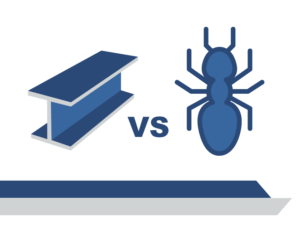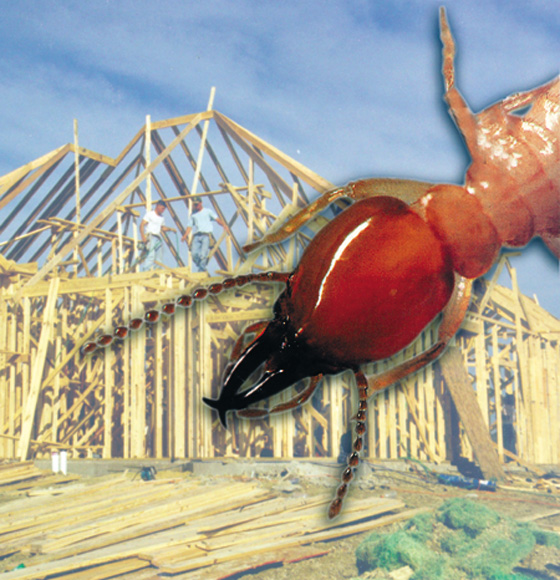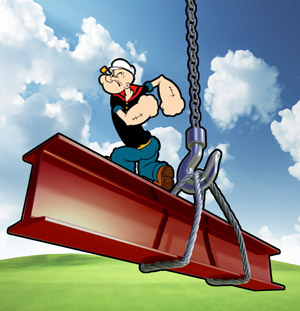How a Metal Building Kit— and a Little Spinach— Save the Day
Are you wondering what Popeye has to do with steel prefab buildings or termites?
 Throughout the years, thousands of people have fought to save their property from the relentless onslaught of ravenous, lumber-eating termites. They douse everything with strong chemicals— while spending buckets of cash.
Throughout the years, thousands of people have fought to save their property from the relentless onslaught of ravenous, lumber-eating termites. They douse everything with strong chemicals— while spending buckets of cash.
Oddly enough, the cartoon character Popeye had the solution for termites over 60 years ago.
Taming Termites with Spinach— and Prefab Steel Buildings
In 1956, the Popeye cartoon Insect to Injury was released in which a termite horde systematically destroys Popeye’s just completed home.
So, how did Popeye save the day and defeat the tiny terrorists?
By gulping down a can of spinach, shifting into high gear, and rebuilding from the ground up— with steel.
(Granted, the termites in this epic look more like angry black ants on steroids, but you get the idea. Let’s allow room for artistic license.)
Today, we know that famous sailorman had the right idea.
A Hard Look at the High Costs of Damage by Termites
Cartoons aside, termites are no laughing matter.
Termites typically cause more damage in the U.S. each year than fires, floods, and tornadoes combined. In fact, Americans shell out $5 billion annually for termite control and repairs.
Sadly, termites damage over 600,000 U.S. homes every year. Unfortunately, most insurance does not cover termite damage.
To make matters worse, a queen termite lays thousands of eggs per year. Astoundingly, she puts out as many as 2,000 eggs in a single day!
Shockingly, a native subterranean termite colony may contain up to a million of the tiny building-wreckers.
A Formosan Termite Colony Devours a Pound of Wood Daily
 And get this: the most voracious variety—the dreaded Formosan termite— may have two to ten million insects in a single colony!
And get this: the most voracious variety—the dreaded Formosan termite— may have two to ten million insects in a single colony!
Left unchecked, Formosan termites cause extensive damage to a wooden structure in only six months.
Termites are especially destructive in warm, humid climates like Louisiana, Florida, and Hawaii.
One former wood builder in Hawaii once jokingly claimed that by the time he finished the top step of a wooden staircase, the termites had already eaten away the two bottom steps. In fact, that is exactly why he switched to prefab steel buildings.
A RHINO Metal Building Kit is “Strong to the Finish”
Popeye had to rebuild from scratch. However, today’s builders have the advantage of using metal prefab steel buildings like those from RHINO Steel Building Systems. Our building kits make projects go together quickly and easily.
With a RHINO metal building kit, all the framing is precision cut to length, welded, drilled, and marked at a factory. The kit ships directly to the job site for simple bolt-and-screw together erection.
Indeed, RHINO’s framing is guaranteed to meet or exceed all your current local building requirements for the life of the structure. As an added bonus, each metal building kit is certified by an engineer licensed for that state.
What Termite Can Make a Meal of Steel Prefab Buildings?
Metal building kits save the owner more than just costly chemical termite treatments. In addition, steel prefab buildings also prevent you from spending thousands of dollars for costly termite repairs.
The best way to defeat termites is not to give them a food supply. After all, even Formosan termites cannot make a meal of steel.
Start building with steel.
Conclusion
Learn from Popeye’s battle with termites. Follow his example. Eat your spinach— and build with termite-resistant RHINO steel building kits.
RHINO: A Quality Building Product at a Competitive Price
RHINO supplies strong steel prefab buildings for individuals, as well as commercial and industrial builders. Call the RHINO hotline to learn more: Our number is 940.383.9566.
(Updated 12-4-2019. Originally published 10-26-2012.)

